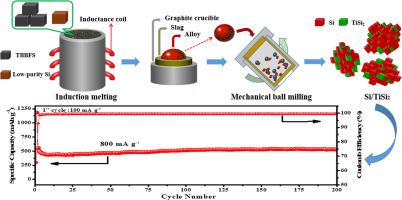Journal of Alloys and Compounds ( IF 5.8 ) Pub Date : 2021-05-01 , DOI: 10.1016/j.jallcom.2021.160125 Yuchao Zhang , Mingyang Chen , Zhiyuan Chen , Ye Wang , Shi Li , Pengxin Duan , Yanjun Zhong , Zhenguo Wu , Xiaodong Guo , Zhengjuan Yan , Xinlong Wang

|
The large volume expansion and poor conductivity leading to the deterioration of electrochemical performance, is a significant challenge for Si-anode materials for practical applications. Previous researches have indicated that introducing a TiSi2 buffer with high conductivity to form Si/TiSi2 composites can effectively improve the electrochemical performance of Si anode. However, the facile and low-cost synthesis of Si/TiSi2 composites remains challenging. In this study, we propose a novel approach to preparing Si/TiSi2 composites as anode materials for lithium-ion batteries by coupling photovoltaic (PV) silicon waste (simulated using inexpensive low-purity Si (98.8%) in experiments) and metallurgical waste (Ti-bearing blast furnace slag, TBBFS) via a new method combining induction melting and mechanical ball milling. A series of Si/TiSi2 materials were obtained using different ratios of raw materials and investigated using SEM, TEM, XRD, XPS and electrochemical performance tests. The results show that TiSi2 not only acts as a buffer for the bulk expansion of Si, but also improves the electrical conductivity; therefore, the Si/TiSi2 materials exhibit enhanced cycling stability when more TiSi2 is introduced. The sample prepared using a low-purity Si and TBBFS with a mass ratio of 1:3 delivered a reversible capacity of 530 mAh g−1 after 200 cycles at a charge-discharge current density of 800 mA g−1. This work not only provides a new strategy and technology for introducing TiSi2 into Si-based anode materials, but also provides a green and sustainable technical route for the high value-added recycling of Ti-bearing blast furnace slag.
中文翻译:

通过直接利用低纯度含硅和钛的高炉矿渣,构建稳定循环的Si / TiSi 2复合材料作为锂离子电池的负极材料
大体积膨胀和差的电导率导致电化学性能的恶化,对于实际应用的硅阳极材料是一个重大挑战。已有研究表明,引入高导电率的TiSi 2缓冲液形成Si / TiSi 2复合材料可以有效提高Si阳极的电化学性能。然而,Si / TiSi 2复合材料的简便且低成本的合成仍然具有挑战性。在这项研究中,我们提出了一种制备Si / TiSi 2的新颖方法通过结合一种新方法结合使用光伏(PV)硅废料(在实验中使用廉价的低纯度Si(98.8%进行模拟))和冶金废料(含钛高炉矿渣,TBBFS)将复合材料用作锂离子电池的负极材料感应熔炼和机械球磨。使用不同的原料比例获得了一系列Si / TiSi 2材料,并使用SEM,TEM,XRD,XPS和电化学性能测试进行了研究。结果表明,TiSi 2不仅可以作为硅块体膨胀的缓冲剂,而且可以提高导电性。因此,当更多的TiSi 2时,Si / TiSi 2材料表现出增强的循环稳定性介绍。使用质量比为1:3的低纯度Si和TBBFS制备的样品在200个循环后以800 mA g -1的充放电电流密度提供了530 mAh g -1的可逆容量。这项工作不仅为将TiSi 2引入硅基阳极材料提供了新的策略和技术,而且为含钛高炉渣的高附加值回收提供了绿色和可持续的技术路线。




















































 京公网安备 11010802027423号
京公网安备 11010802027423号